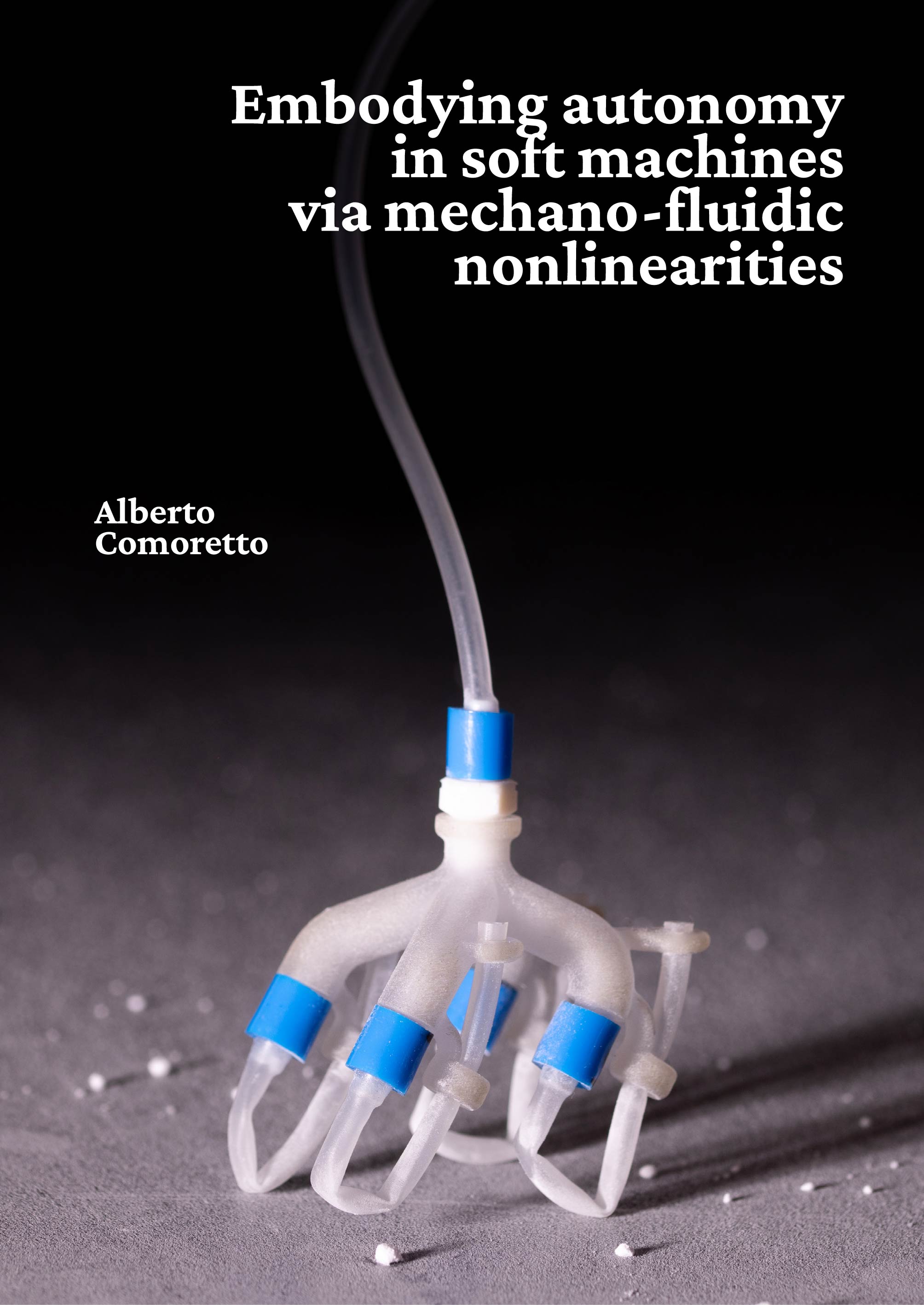Embodying autonomy in soft machines via mechano-fluidic nonlinearities
Animals display mesmerizing autonomous behaviors through complex interplays of physical interactions within their soft bodies and with the environment in which they live, often even bypassing their central brain. Contrarily, artificial robots typically perform tasks by relying on centralized computers that send sequential control signals to actuators. Here, we ask how we can embody autonomous behaviors directly in the physical structure of soft machines, beyond processors and control signals, similar to how natural systems often behave. Through this largely explorative study, we investigate soft machines with mechanical elements, such as elastic shells and tubes, coupled with the fluidic domain of airflow and pressure. We propose that the richness of nonlinear mechano-fluidic phenomena can set the basis for autonomy without a brain, by enabling complex behaviors to emerge directly from the physics of the soft machines rather than being forced from upstream by hardware and software.
We start by embodying memory effects directly in the machines’ structure. This allows soft machines, which usually respond passively to interactions, to remember past interactions even after they occur. We harness the highly nonlinear behavior of elastic shells to provide bistability to the fluidic properties of an enclosed cavity. This bistability allows a locomoting soft machine to switch between stable behaviors when tubes in its fluidic circuits kink or unkink upon touch interactions. We implement both long- and short-term memory in a machine that programs its behaviors in response to a human user and that autonomously changes direction after detecting a wall. Via purely geometry and elasticity, embodying memory enables passive physical structures to exhibit programmability features typically reserved for computer-based systems.
We then explore a peculiar behavior of a specific device in our soft machines: a self-oscillating valve where two distinct modes, pressure regulation and oscillation, coexist given the same operating conditions. We explain this coexistence phenomenon through a lumped-parameter model that couples the mechanical and the fluidic domains, capturing the highly nonlinear characteristics of the valve. Using analytical tools from dynamical systems theory, we learn the mechanical and fluidic conditions under which the coexistence holds. In addition, our analytical model informs an updated design for the valve that inhibits the regulation regime, thereby proving useful for applications such as the cyclic activation of a soft artificial heart that should not stop beating once implanted.
Following these designer approaches, we next study autonomous behaviors that emerge from the physics of body-environment dynamics. We observe a self-oscillating phenomenon peculiar to soft tubes with flowing air, where kink instabilities form, travel, and disappear along the tube itself. As this behavior is periodic and asymmetric, we find it equivalent to the motion of animals’ limbs. As such, the tube represents a fundamental building block for autonomous locomotion by co-localizing multiple functionalities such as oscillation, actuation, and motion sequencing within the same physical phenomenon. We experimentally show that multiple of these self-oscillating limbs synchronize at relatively high frequencies through internal fluidic coupling and external mechanical coupling with the environment, leading to rapid locomotion. As the synchronization patterns are responsive to external interactions, these seemingly simple machines, composed of only tubes as limbs and lacking a brain, exhibit emergent autonomous behaviors, including obstacle avoidance, amphibious gait transitions, and phototaxis.
Lastly, we aim to overcome the need for bulky external energy sources, such as electric pumps and batteries, by instilling activity directly in the physical composition of soft fluidic machines. In particular, we study active oscillations emerging from the coupling between elastic membranes and a catalytic reaction of an energy-dense fuel. We devise a system where a catalyst embedded in an elastomeric membrane is suspended over a tank filled with liquid hydrogen peroxide as fuel. With both experiments and a basic lumped-parameter model, we show that separate timescales intrinsic to the catalytic reaction lead to active oscillations where the reaction activates and deactivates spontaneously, cyclically inflating and deflating the membrane. As such, we demonstrate a soft device that harnesses the nonlinear physical characteristic of a catalytic reaction to self-sustain oscillations, drawing power from within the system itself.
In conclusion, through this explorative journey we show how mechano-fluidic nonlinearities represent a powerful tool to instill complex autonomous behaviors directly in the structure of seemingly simple machines. From our exploration, we conclude that nonlinearities enable the co-localization of multiple qualitatively distinct functionalities within the same device for increased behavioral complexity, and aid rich couplings both within the machine and with the external environment, leading to emergent, responsive behaviors. By materializing the concepts of embodied memory, soft dynamical systems, physical synchronization of limbs, and active oscillations, this work as a whole lays the foundation for future artificial creatures that will autonomously roam around our world, exhibiting rich and robust behaviors while not possessing, or fully depending on, intricate brains.



